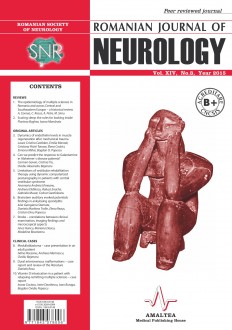SELECT ISSUE

Indexed

| |

|
|
|
| |
|
|
|

|
|
|
|
|
|
| |
|
|
HIGHLIGHTS
National Awards “Science and Research”
NEW! RJN has announced the annually National Award for "Science and Research" for the best scientific articles published throughout the year in the official journal.
Read the Recommendations for the Conduct, Reporting, Editing, and Publication of Scholarly work in Medical Journals.
The published medical research literature is a global public good. Medical journal editors have a social responsibility to promote global health by publishing, whenever possible, research that furthers health worldwide.
BRAINSTEM AUDITORY EVOKED POTENTIALS FINDINGS IN ANKYLOSING SPONDYLITIS
Iulia Georgiana Stamate, Daniela Marilena Trofin, Elena Rezus and Cristian Dinu Popescu
ABSTRACT
Background. Ankylosing spondylitis (AS) is a chronic inflammatory potentially debilitating disease predominantly affecting the axial skeleton. A few intermittently published studies and research have proved the existence of some not yet explained neurophysiologic abnormalities in patients with AS.
Objectives. The aim of this study was to investigate the brainstem auditory evoked potentials and its relation with clinical findings, laboratory tests and pharmacological therapy used in patients with AS.
Material and method. Thirty-nine patients with AS were included in the study. The control group was composed of 50 healthy subjects. BAEP were recorded for all subjects. Patients were assessed by clinical specific tests, in- flammatory laboratory tests, Bath Ankylosing Spondylitis Functional Index (BASFI), Bath Ankylosing Spondylitis Disease Activity Index (BASDAI) and type of pharmacological therapy.
Results. The results have shown differences between the control group and the patients with AS in most of the wave latencies. Correlations Schober test, Ott index, chest expansion measurement and BASDAI were significant for some waves. CRP seems to be more valuable than ESR as a possible marker for neurologic subclinical involvement. Axial AS is more likely to be associated with BAEP abnormalities. There were also differences between the group with TNF alpha blockers therapy comparative with the group with other therapies.
Conclusions. This study highlights some abnormalities of BAEP in patients with AS. Diagnosis of multiple sclerosis or demyelination due to administration of TNF alpha blockers should be excluded in medical practice. Collaboration between neurologists and rheumatologists should be considered in monitoring AS patients.
Keywords: ankylosing spondylitis, auditory evoked potentials, TNF-alpha blockers, subclinical neurologic involvement
Full text | PDF
